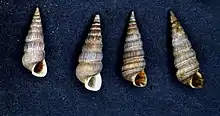Cerithideopsis pliculosa
Cerithideopsis pliculosa, common name the plicate horn shell, is a species of sea snail, a marine gastropod mollusk in the family Potamididae.[1]
| Cerithideopsis pliculosa | |
|---|---|
 | |
| Four shells of Cerithideopsis pliculosa (museum specimens at Naturalis Biodiversity Center) | |
| Scientific classification | |
| Kingdom: | |
| Phylum: | |
| Class: | |
| (unranked): | |
| Superfamily: | |
| Family: | |
| Genus: | |
| Species: | C. pliculosa |
| Binomial name | |
| Cerithideopsis pliculosa (Menke, 1829) | |
| Synonyms | |
| |
Distribution
The species is found on the Caribbean coast of the US. It is genetically distinct from Cerithideopsis californica of the Pacific coast of the US. The two species became isolated by the emergence of the Isthmus of Panama three million years ago. DNA analysis suggests that there was some crossing of the Isthmus in both directions, and the common shorebirds called willets are suspected as carriers. Willet droppings have been placed in dishes of salt water with the result that some snails hatched out.[2]
Habitat
The species has been found in water at recorded depths from 0 to 2 m.[3]
References
- Bouchet, P. (2014). Cerithideopsis pliculosa (Menke, 1829). Accessed through: World Register of Marine Species at http://www.marinespecies.org/aphia.php?p=taxdetails&id=758582 on 2014-03-20
- Alan de Queiroz, The Monkey's Voyage: How Improbable Journeys Shaped the History of Life, Basic Books, 2014, p. 224.
- Welch J. J. (2010). "The "Island Rule" and Deep-Sea Gastropods: Re-Examining the Evidence". PLoS ONE 5(1): e8776. doi:10.1371/journal.pone.0008776.
- Reid D.G. & Claremont M. (2014) The genus Cerithideopsis Thiele, 1929 (Gastropoda: Potamididae) in the Indo-West Pacific region. Zootaxa 3779(1): 61-80
- Rosenberg, G.; Moretzsohn, F.; García, E. F. (2009). Gastropoda (Mollusca) of the Gulf of Mexico, Pp. 579–699 in: Felder, D.L. and D.K. Camp (eds.), Gulf of Mexico–Origins, Waters, and Biota. Texas A&M Press, College Station, Texas.
External links
- "Cerithidea (Cerithideopsis) pliculosa". Gastropods.com. Retrieved 15 January 2019.
Wikimedia Commons has media related to Cerithideopsis pliculosa.
This article is issued from Wikipedia. The text is licensed under Creative Commons - Attribution - Sharealike. Additional terms may apply for the media files.